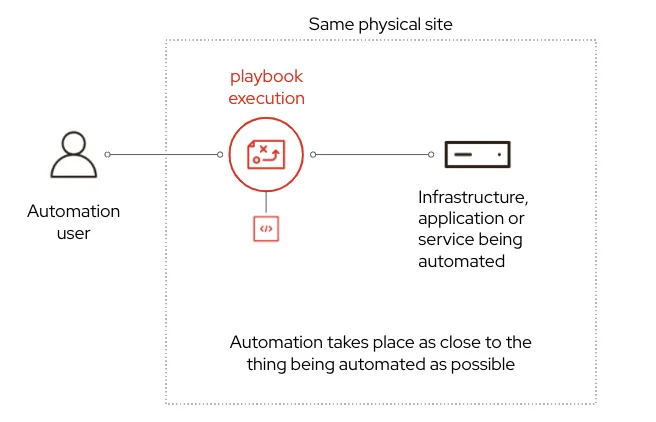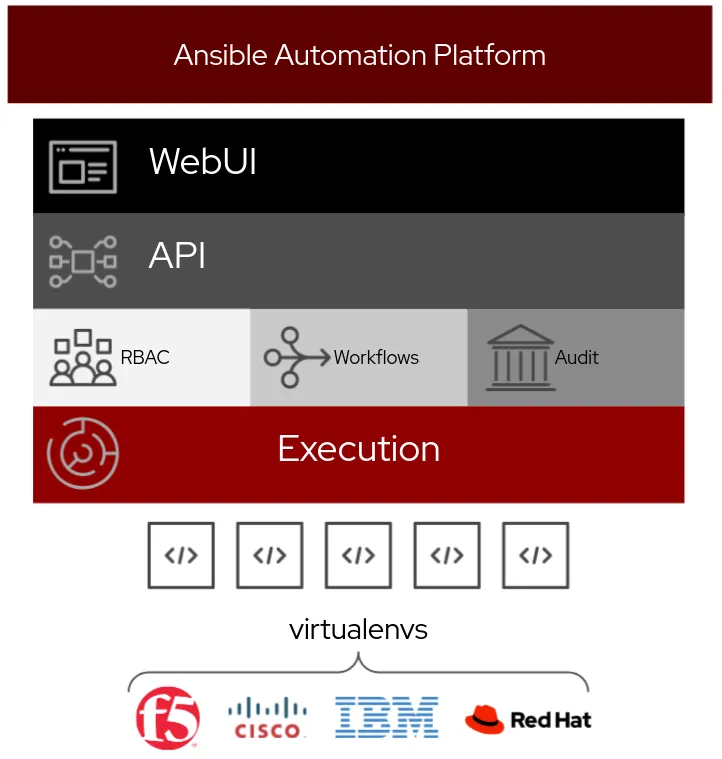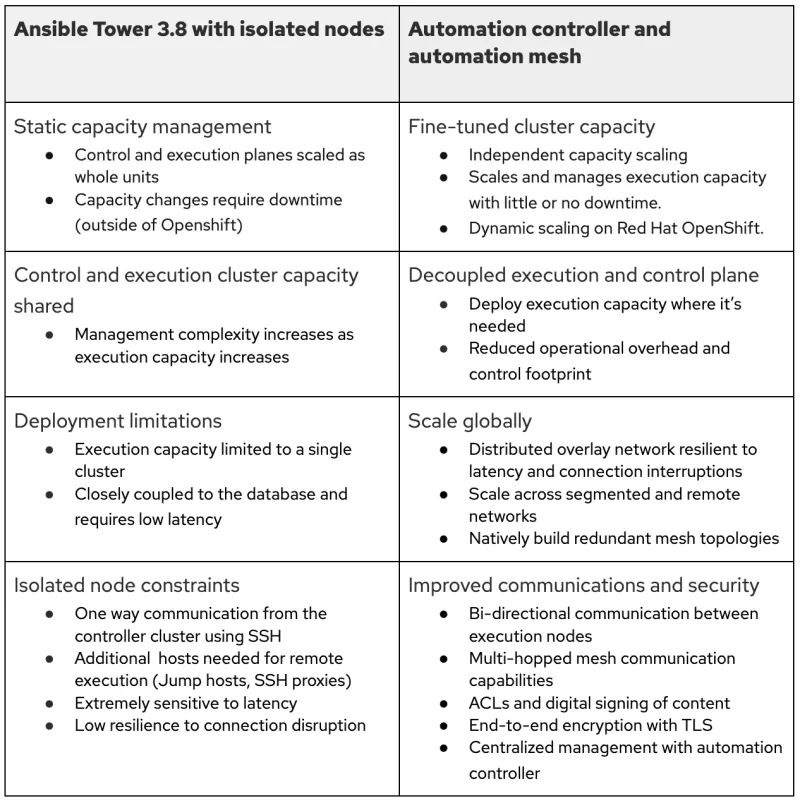
As part of the most recent Ansible Automation Platform 2.1 release announced December 2, 2021, we are excited to debut one of the most long-awaited features of the release: automation mesh.
Automation mesh enables you to reliably and consistently automate at scale, across on-premises environments, the hybrid cloud, and to the edge. It delivers flexible design options, from single-site deployments to platform installations spanning the globe, wherever you are in your automation journey.
This blog details the benefits of automation mesh, a high-level overview of how it works, and how it helps you simplify scaling your automation across your enterprise environments. We are planning more detailed technical deep dive blogs with automation mesh use cases in the future, so stay tuned!
Why automation mesh?
Scaling automation across different platforms and locations is challenging. How do you ensure your automation executes consistently while still managing your platform centrally? How do you automate endpoints in remote areas with limited connectivity?
The best practice to overcome these challenges is delivering and running automation closer to the devices that need it. This design limits execution interruptions, which lead to inconsistent states, and possible downtime to IT services.

Enterprises, however, have multiple environments that span different locations, each with niche automation requirements. Delivering and managing consistent, reliable automation across these environments is arduous and time consuming.

Automation mesh aims to simplify this undertaking and, in conjunction with automation controller, provides a scalable, reliable solution that reduces the operational overhead associated with multi-site deployments.
To provide context on how automation mesh helps overcome the challenges associated with distributing your automation, let’s briefly revisit what was previously known as Red Hat Ansible Tower and isolated node architecture.
Before: Ansible Tower and isolated nodes
Ansible Tower and isolated nodes made scaling across multiple regions and complex networks challenging to manage.

Rigid and tightly coupled
Ansible Tower’s tightly coupled shared execution and control capacity made scaling automation challenging to implement and manage. Increasing your execution capacity meant the entire cluster had to be proportionately expanded. This process was cumbersome and needed downtime if not in a Red Hat OpenShift environment.
Limited deployment options
This monolithic design also limited execution capacity to a single cluster, making it sensitive to network latency and connection disruptions. Architects were limited in their design options and often needed multiple Ansible Tower clusters or isolated nodes to expand automation capacity across regions or constrained networks.
Isolated node limitations
Isolated nodes provided limited localized execution capacity and only offered one-way communication. Isolated nodes were susceptible to network latency and connection disruptions and needed ancillary tools, such as Secure Shell (SSH) proxies and jump hosts to overcome networking constraints.
Now: Automation mesh and automation controller
While pushing changes to one site was straightforward using the previous architecture, how do you reliably and consistently deploy changes to dozens of locations across the globe? The answer to this is automation mesh.

Simplify your operations
Automation mesh removes the dependency on ancillary tools such as jump hosts and SSH proxies by localizing automation. The distributed design reduces the overall platform footprint and operational overhead associated with managing multiple, isolated platform clusters.
Design for your enterprise
Automation mesh offers design flexibility, from single-site deployments to platform installations spanning the globe. Automation mesh is a multi-directional, multi-hopped overlay network delivering automation across constrained networks, such as DMZs and VPCs, to remote endpoints not directly connected to the automation controller.
Start locally, scale globally
Automation mesh offers a simple, flexible and reliable way to scale your control and execution capacity independently, delivering automation closer to the endpoints that need it with little or no downtime.
Scale reliably
Automation mesh introduces fault tolerance and redundancy via native peering capabilities and new features, such as hop nodes. Distributing automation execution to the locations where it's needed makes the platform resilient to network disruptions and latency.
Scale securely
Automation mesh includes security features, such as Access Control Lists (ACL), and Transport Layer Security (TLS) authentication and encryption, providing a security-first approach to scaling automation. Automation mesh is centrally managed via controller, enabling you to leverage features, such as RBAC (Role-Based Access Control) and authentication, to secure your automation mesh.
Automation mesh features and benefits summary
The table below summarizes the benefits and changes introduced with automation mesh:

Frequently asked questions:
Is automation mesh the same as isolated nodes?
Yes, and no. The technology utilized to accomplish the same goal is different. Automation mesh replaces and enhances isolated node functionality. Automation mesh effectively replaces the need for SSH jump hosts and provides an overlay network for greater global reach while providing increased performance.
How do I deploy and remove automation mesh nodes?
Automation mesh nodes are installed and removed using the Ansible Automation Platform installer. The Ansible Automation Platform 2.1 release introduced new sections to the installer inventory file for automation mesh configuration.
How can I verify and check my automation mesh configuration before installing it?
The installer performs sanity checks on the automation mesh configuration and, if there are errors, will warn you before you deploy. Also, the installer can generate a GraphViz file providing a visual representation of your automation mesh topology. You can then review your mesh layout before continuing your installation.
Please stay tuned for technical Ansible automation blogs that will cover these topics in more depth. We have created a blog section just for automation mesh.
Key takeaways
The automation mesh component of Ansible Automation Platform provides a simple and robust framework to scale automation from single-site deployments to installations spanning the globe.
With its flexible, multi-directional communication layer and native peering capabilities, you can reach further with improved reliability and less sensitivity to latency and connection disruptions.
Native security features such as TLS authentication and encryption and additional access controls means you can rely on Ansible Automation Platform to help securely expand the boundaries of what is possible for your entire enterprise IT estate.
In the end, automation mesh is a must-have component of Ansible Automation Platform that acts as a force multiplier for global, enterprise-wide automation.
Where to go next
There are several resources available to learn more about automation mesh:
- If you want to find out more about the Ansible Automation Platform 2.1 release, look at the Introducing Ansible Automation Platform 2.1 blog by Sean Cavanaugh.
- Check out the self-paced, interactive labs available to get hands-on with Ansible Automation Platform 2.
- Want to try Ansible Automation Platform in your own environment? We offer an Ansible Automation Platform 2.1 trial.
- Visit the automation mesh official documentation for more detailed technical information.
A special thanks to Anshul Behl for his contributions to this blog.
저자 소개
Craig Brandt is a Principal Technical Marketing Manager for Ansible Automation Platform. Prior to this position, Craig served as a Solution Architect representing Red Hat at the IBM Services Integration Hub. He focused on large, complex deals that covered EMEA, LATAM and Canada regions. He brings over 16 years of experience in the IT field that covers automation, containerisation, management, operations, development and solution design
유사한 검색 결과
Data-driven automation with Red Hat Ansible Automation Platform
Ford's keyless strategy for managing 200+ Red Hat OpenShift clusters
Technically Speaking | Platform engineering for AI agents
Technically Speaking | Driving healthcare discoveries with AI
채널별 검색
오토메이션
기술, 팀, 인프라를 위한 IT 자동화 최신 동향
인공지능
고객이 어디서나 AI 워크로드를 실행할 수 있도록 지원하는 플랫폼 업데이트
오픈 하이브리드 클라우드
하이브리드 클라우드로 더욱 유연한 미래를 구축하는 방법을 알아보세요
보안
환경과 기술 전반에 걸쳐 리스크를 감소하는 방법에 대한 최신 정보
엣지 컴퓨팅
엣지에서의 운영을 단순화하는 플랫폼 업데이트
인프라
세계적으로 인정받은 기업용 Linux 플랫폼에 대한 최신 정보
애플리케이션
복잡한 애플리케이션에 대한 솔루션 더 보기
가상화
온프레미스와 클라우드 환경에서 워크로드를 유연하게 운영하기 위한 엔터프라이즈 가상화의 미래
